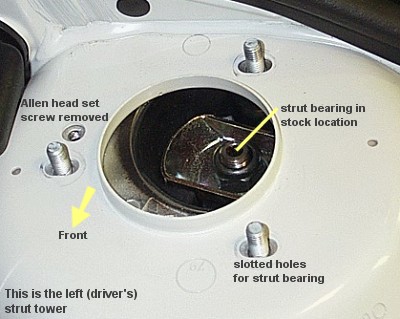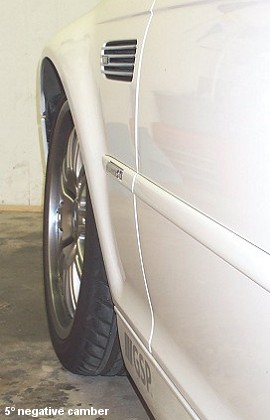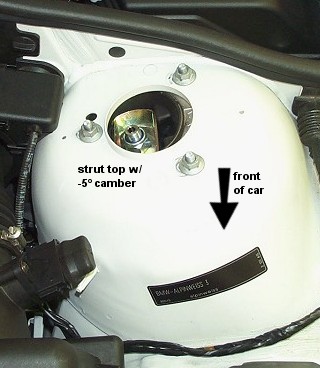|
|
| Swapping Factory Strut Bearings for More Negative Camber |
|
|
|
|
|
| Swapping Factory Strut Bearings for More Negative Camber |
|
|
 The stock strut-top bearings on the E46 M3 can be rotated into
several positions to effect a change in front camber (and caster as a side-effect). The strut
bearings can also be swapped from left-to-right. Since the
strut bearings have three studs (and can be rotated into
three positions) there are six (6) possible front end strut
bearing arrangements which are theoretically possible.
The stock strut-top bearings on the E46 M3 can be rotated into
several positions to effect a change in front camber (and caster as a side-effect). The strut
bearings can also be swapped from left-to-right. Since the
strut bearings have three studs (and can be rotated into
three positions) there are six (6) possible front end strut
bearing arrangements which are theoretically possible.
Of these six possibilities, three are realistic. These are discussed on this page. It should be noted that all these results were obtained on a lowered M3. I played with the strut top bearings during the same time that I installed a Bilstein PSS 9 system on the car. With an E46 M3 at factory ride-height, the camber results discussed here would be different due to the "camber-curve" built into the front suspension (i.e. camber changes with ride height)... |
|
The first strut-top bearing arrangement to mention is obviously the stock factory setup. As shown in the first photo there is some scope to adjust camber in the factory orientation simply by sliding the strut bearings inwards or outwards in the slotted holes in the strut tower. I have heard it said that sliding the strut bearings from their factory position in the middle of the slots to the inside limit will yield about 0.5° additional negative camber. This would imply that the full range of camber adjustment achieved from sliding the strut bearings from one end of the slots to the other end is about 1.0°. My gut feeling is that it is less than this but I have not measured it, unfortunately. When oriented according to the factory setup the strut bearings will have their arrows pointing towards the front of the car, and the strut bearing marked "R" (next to the arrow) will be on the right (passenger's) side, while the strut bearing marked "L" will be on the left (driver's) side of the car. The "arrows" in question are cast into the top of the strut bearings and are visible in the summary photo in the link below... |
 The second position of interest is what I call the "5 degree solution".
This configuration yielded 5 degrees of negative camber as shown in the photo
to the right. The details of this configuration are that the strut top
bearings are left on their respective sides (left on left, right on right),
but the bearings are rotated through one position. The arrows on the strut
bearings end up pointing outwards and slightly back (instead of forward). Also
the bearings are slid to the "outside" of the slots in the strut tower
(otherwise you would have have even more negative camber).
The second position of interest is what I call the "5 degree solution".
This configuration yielded 5 degrees of negative camber as shown in the photo
to the right. The details of this configuration are that the strut top
bearings are left on their respective sides (left on left, right on right),
but the bearings are rotated through one position. The arrows on the strut
bearings end up pointing outwards and slightly back (instead of forward). Also
the bearings are slid to the "outside" of the slots in the strut tower
(otherwise you would have have even more negative camber).
This is tough to visualize without a picture so it might be useful to skip down to the link below and view the summary photo. One thing is clear - with 5° of negative camber one could probably stuff a 10" wide wheel
under the front fender!
|
|
Click here to see the various strut bearing configurations (will open a new window)... |
 The photo on the left shows how the top of the strut tower looked with the strut
-5° camber position. This setup was obviously not going to work. This is way too much
negative camber. This configuration also reduced the caster by quite a bit - an undesired
side-effect (though no negative bump-steer effects were noticed as some have suggested).
A long hard look at the strut bearings eventually showed
that swapping the bearings from left to right, as well as rotating, them might yield desired solution
(I had been told by a reputable source that I should swap them, but I had erroneously
convinced myself that it would make no difference, and that only the same three solutions would be available).
The photo on the left shows how the top of the strut tower looked with the strut
-5° camber position. This setup was obviously not going to work. This is way too much
negative camber. This configuration also reduced the caster by quite a bit - an undesired
side-effect (though no negative bump-steer effects were noticed as some have suggested).
A long hard look at the strut bearings eventually showed
that swapping the bearings from left to right, as well as rotating, them might yield desired solution
(I had been told by a reputable source that I should swap them, but I had erroneously
convinced myself that it would make no difference, and that only the same three solutions would be available).
In the end the chosen solution was to swap the strut bearings - left to right and right to left - as well as rotating them through one position. The strut bearings are such that their arrows point forwards and inwards as shown in the link above. I also slid the strut bearings to the full inside position in the tower slots. This configuration yields about 3° negative camber, with room to back off to perhaps 2.2° - 2.3° if you were to slide the strut bearings to the outside of the slots in this configuration. Another plus is that the change in caster is negligible (only a slight decrease, probably a few tenth's of a degree). |
|
The method just described allows one to adjust the negative camber on an E46 M3 while still retaining the factory strut top bearings. Thus the factory ride quality is retained due to the shock absorption afforded by the thick rubber pad in the strut bearing. The downside is that this pad eats up a lot of suspension travel. This is where a true camber plate w/ spherical bearings helps. A camber plate allows a greater range of camber (and caster) adjustment, and opens up additional travel to prevent bottoming on lowered cars. The one negative point is that some additional "noise" comes into the cabin due to the lack of any rubber in the system. Still, many people consider camber plates to be perfectly streetable. It's really a matter of personal preference. |
|